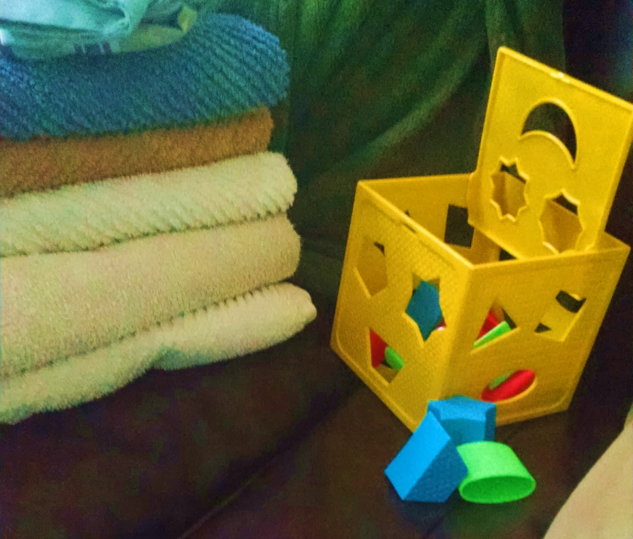
Do you have a child like this? You know, this child is excited to tell you about something new and amazing he or she just saw outside. You hear your name as they run into the house and begin telling you all about it, but after the first few words, they hit an impasse:
“Mommy, mommy, guess what? I was outside and…and… I was outside when the…the…there was a leaf that was…it was… Are you making lunch?”
I used to take these situations from an educational point of view. I mean MY education. Listening to the unfolding of an important story (at least to my child) while he struggled to stay focused long enough to tell it built a great deal of patience on my part. And maybe some acting skills, too.
After all, you try to keep looking excitedly at that little face as their mind flows from one point to another in a seemingly haphazard way as they try to relate their news. I think I am ready for a stage production.
Living with a distractible child is a fun, challenging, and definitely humorous endeavor. But it also can be a bit frustrating.
I remember many evenings at the dinner table, happily talking with the family about our day when all of a sudden one of our children just falls off the chair. It is not like he was fidgeting or bouncing or tipping the chair.
No. One minute he was sitting still, scooping a spoonful of food into his mouth and the next minute, he was on the floor. What happened? Did the Earth suddenly tip? Did the chair lose its density and the child just fall through it?
Of course not. This child was easily distracted, wasn’t paying attention to what he was doing, and he edged his way to the end of the seat and simply fell over. Thankfully, he rarely got hurt, though the floor often got baptized in spaghetti sauce, soup, applesauce, and whatever other food item we were eating.
Needless to say, it was challenging trying to homeschool this sweet, busy one. Early on, I noticed his distractibility when at the age of three I asked him to do a simple task for me.
“Honey, please take these folded socks to your room and put them on your bed.”
He happily nodded his head, took the socks and moved through our dining room in a direct path to his room. But then he stopped. He looked up at the wall. Well, there wasn’t anything there! What caught his attention?
Oh, I know. My child is distracted by wallpaper!! The intricate designs of the old-fashioned paper in our 1950s house was so interesting to him that he instantly forgot what he was doing to stare at its fascinating presence. Never mind that he had trounced through there a hundred times a day. It was just difficult to keep a directive in his mind for very long. And, over the years, I realized that it was not intentional disobedience. He truly had a hard time staying focused.
Once he hit the elementary school years, I quickly discovered it was challenging for him to keep on task when it came to math problems. I knew he understood the material, because as I went over it with him verbally or had him do one problem for me, he would do it well.
And forget tests and quizzes. It would take him up to an hour to complete a short quiz. I had to stay nearby to remind him to focus back on that paper.
I began to try to remove distractions by having him do his math quizzes in a less exciting location in the house or a place without his siblings. It didn’t work. Remember, wallpaper distracts this child!
Once I tried using one of those white, three-sided, cardboard display boards on his desk so that he wouldn’t see anything else in the room. After a few minutes, I peeked in to see how he was doing. No, of course he wasn’t working on his problems. He had his pointer finger up against the board, running the nail to the right and left over the bumps of the corrugated cardboard!
OK, NOW what? I began thinking to myself, How can a child who sits still for hours, working on an intricate Lego design not sit still for even a few minutes to complete a math quiz?
Then it hit me.
I rummaged through our arsenal of Lego models and looked for a small one. Then I pulled out a math quiz. I looked at the model instructions. There were 17 steps. I crossed off the last three math problems of the 20-problem quiz.
Then I presented my child with my idea: “I know you love to build models, so I think I have something that may help you keep your attention while you do your math work. First, complete problem number one on the quiz. Then do step one in the Lego book. Next, do math problem number two, and Lego step two. And so on.”
He smiled at me and sat down. Do you know that he completed that math quiz in 20 minutes??
Now, short of having him bring an entire box of Lego models with him to his SAT exam, I would have to work on this method and help him find other ways to keep his focus.
But this helped HIM to see that he could do it. He realized that he understood the material and could actually stay focused. He felt ABLE.
You see, he was now old enough to realize that he was distracted by things. He saw how other people could stay focused, but he had a hard time of it.
Now, this isn’t a discourse to discuss whether he should be tested or not, or whether he needed medication or not. I am writing about this to encourage you to be engaged with your children.
They know much more about what’s going on than you think they do. Your job as parent is to help them learn and grow in this world. They are your greatest mission field. After understanding who their Lord and Savior is, they then need to know how He desires to have a relationship with them. You are mentoring them on how to navigate living in this world with the gifts and challenges it brings.
One of the best ways to do that is to learn how to navigate YOUR gifts and challenges. By asking God for His strength in your weakness, you will be showing your children the greatest way to deal with any difficulty they face. Ask God for wisdom in dealing with these situations.
Spend time praying with your children, first asking them about any struggles they have and then bringing those issues to the Lord.
He can give us the creativity we need. He can give us the wisdom to walk through the challenges. Your loving Father cherishes you and wants you to walk strong!
Show that to your children by living it. That day-by-day living in the Lord, in a slow, ordinary way…facing each challenge or joy as it comes is what makes this life extraordinary!
And for Five Smart Strategies to Engage a Distracted Learner, click here.















































